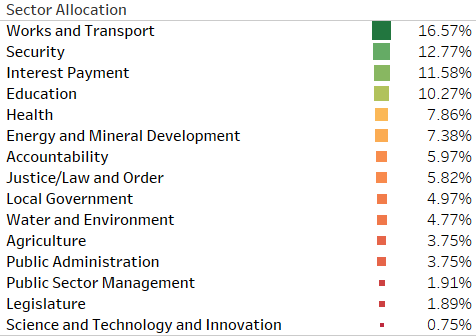Kampala, 11th June 2020: Uganda’s Minister of Finance Planning and Economic Development (MoFPED), Hon. Matia Kasaija read the Ugx. 45 trillion national budgets for the FY 2020/21.
Every year, the national budget is anchored on a tactical theme. This year’s budget theme is ‘stimulating the economy to safeguard livelihoods, jobs, business, and industrial recovery.‘ Following the coronavirus pandemic that hit the country, and caused a lockdown of more than 70 days, and closure of schools, the economy needs to be stimulated indeed to safeguard livelihoods, jobs, business, and recover the industry.
Below are brief highlights of the budget allocations in graphs for your quick understanding. The good news is the government continues to focus on local resource mobilization. In the FY2020/21, over 43.7% shall come from tax collections. For this to happen, the local economy must be healthy. Small businesses must be given incentives to thrive. Government has increased import tariffs to discourage consumption of imports in favour of local products.
Table 1: Where will the money come from?

Graph 1: Uganda FY 2020/21 Budget Financing, Ugx. ‘Trillions

- In Table 1 and Graph 1, URA has its work clear cut. 43.7% of the national budget to be financed by revenues from taxes – both direct and indirect. The government’s taxation strategy has been to protect local manufacturers. Taxes on imported products like cosmetics, foods, and other similar products have been increased. For a full listing of respective new import tax rates for import substitution, Budget-changes-2020-21-Budget-Breakfast-04062020FINAL.pdf (344 downloads )
- The government expects to earn Ugx. 1.5 trillion from charges, fines, and penalties. Expect no mercy by traffic police when you drive without insurance cover, valid driving permit, or outside the curfew hours. Maybe that is why curfew hours are not yet extended!
- Some entities earn money like the UPPC, Uganda Printing, and Publishing Corporation, and can use it in their day to day operations without first sending it to the consolidated fund. Government plans to earn about 0.2% that way. This shall promote internal efficiencies.
- Other domestic sources of revenue are planned at Ugx. 8.4 trillion, most of this shall come from loans from local banks, among others. The problem with this kind of financing the budget is usually the high cost they come with. Already, the government of Uganda is overwhelmed with foreign debt, a fact which the Ministry of Finance alluded to during the budget speech, appealing to Ugandans to help pay the debt. But as we all know, government loans are paid by the next generation. Let us empower our children so that they may empower their children to work hard and pay the debts we are acquiring to finance our government expenditure.
- The expected revenue from external sources is Ugx. 15.59 trillion. This money has not been adequately broken down. However, we expect a lot of it to come in the form of loans and foreign aid. If a big proportion comes in the form of debt finance, the economy shall be further beaten.
Table 2: Planned expenditure split – opex vs capex

Graph 2: Capex vs opex split

In Table 2 and Graph 2, the government plans to apply 52.4% of the total spend to recurrent expenditure. And the rest, to capital expenditure. Money for day to day expenses like staff salaries and consumables purchases etc is recurrent expenditure. Money spent in developing assets to benefit the country for so many years to come is capital expenditure, it includes spending on roads, dams, and hospital facilities construction, among others. capital expenditure improves the country’s ability to produce more wealth and create value in the future and is preferred.
In Table 3 and Graph 3, In the top six sectors with the highest government allocations, only the Security Sector that received the budget increment in the FY 2020/21 compared to last year from 11.43% to 12.77% of the total budget allocation. All other sectors have been cut. The elephant in the room on the top three allocations is a ‘sector’ called Interest Payment, which has been allocated 4.1 Trillion. The cost of loans is starting to rear its ugly head in the national budgeting process.
Table 3: Uganda Budget FY 2020/21 Sector Allocations

Graph 3: Sector allocation




For the detailed budget, FY-2020-21-Budget-Speech_Final-Version.pdf (358 downloads )
Ends./








